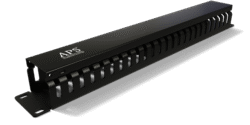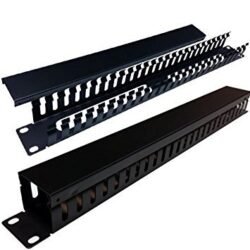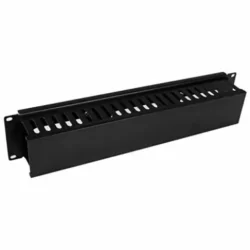Cable Manager – Cable Organization for Network Cabinets
Cable manager is designed to organize, route, and secure cables in structured cabling systems within network cabinets. Whether in a data center, server room, or office IT setup, cable managers prevent tangling, reduce wear and tear, and help maintain proper airflow. This improves the overall performance, safety, and longevity of both the cables and the connected equipment.
Cable managers are available in 1U cable manager and 2U cable manager sizes. They are commonly mounted horizontally or vertically on 19-inch server racks to accommodate different levels of cable density and rack space availability.
-13%
Cable manager
Original price was: KSh2,300.00.KSh2,000.00Current price is: KSh2,000.00. Ex.VAT
Purpose and Benefits
- Organized Cabling: Prevents tangled cables and ensures a clean, structured layout.
- Improved Airflow: Reduces cable obstruction, allowing for better ventilation within the cabinet.
- Easier Maintenance: Simplifies troubleshooting, upgrades, and reconfiguration of equipment.
- Equipment Protection: Minimizes stress on cable ports and connectors, reducing the risk of damage.
- Professional Finish: Enhances the overall appearance and functionality of server racks and network cabinets.
Types of Cable Managers
- 1U Cable Manager A slim option that fits into one rack unit space, ideal for managing patch cables between switches and patch panels in space-constrained setups.
- 2U Cable Manager Provides greater depth and capacity for higher-density cable environments, offering improved separation and routing for large bundles.
- Horizontal Cable Managers Mounted between rack-mounted devices to organize cables running across the width of the rack.
- Vertical Cable Managers Installed along the sides of network cabinets, perfect for routing backbone or trunk cables vertically.
- Finger Duct Panels & D-Ring Managers Allow precise cable routing while maintaining bend radius control to protect against signal loss or cable damage.
Applications
- Data Centers: Supports dense cable environments and optimizes airflow for high-performance systems.
- Server Rooms: Keeps cables between routers, switches, and servers organized and secure.
- Network Closets: Essential for structured cabling in small-to-medium business networks.
- Offices & Homes: Manages cables for computers, entertainment systems, and power distribution units.




